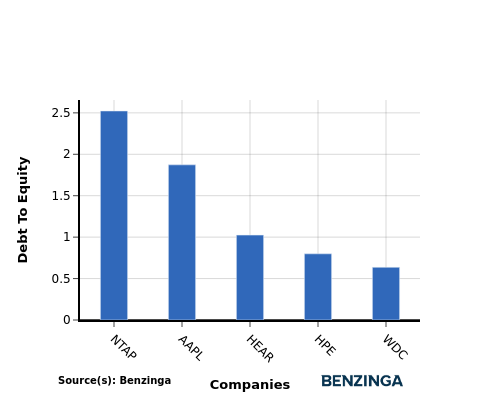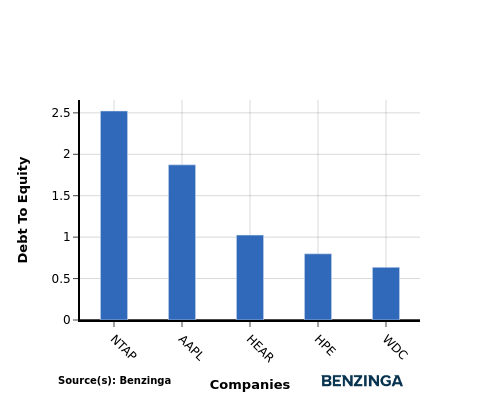In the ever-evolving and intensely competitive business landscape, conducting a thorough company analysis is of utmost importance for investors and industry followers. In this article, we will carry out an in-depth industry comparison, assessing Apple AAPL alongside its primary competitors in the Technology Hardware, Storage & Peripherals industry. By meticulously examining key financial metrics, market positioning, and growth prospects, we aim to offer valuable insights to investors and shed light on company's performance within the industry.
Apple Background
Apple is among the largest companies in the world, with a broad portfolio of hardware and software products targeted at consumers and businesses. Apple's iPhone makes up a majority of the firm sales, and Apple's other products like Mac, iPad, and Watch are designed around the iPhone as the focal point of an expansive software ecosystem. Apple has progressively worked to add new applications, like streaming video, subscription bundles, and augmented reality. The firm designs its own software and semiconductors while working with subcontractors like Foxconn and TSMC to build its products and chips. Slightly less than half of Apple's sales come directly through its flagship stores, with a majority of sales coming indirectly through partnerships and distribution.
| Company | P/E | P/B | P/S | ROE | EBITDA (in billions) | Gross Profit (in billions) | Revenue Growth |
|---|---|---|---|---|---|---|---|
| Apple Inc | 41.48 | 66.94 | 9.94 | 23.83% | $32.5 | $43.88 | 6.07% |
| Hewlett Packard Enterprise Co | 11.09 | 1.13 | 0.95 | 5.72% | $1.44 | $2.61 | 15.06% |
| NetApp Inc | 21.45 | 26.55 | 3.81 | 32.84% | $0.44 | $1.18 | 6.15% |
| Western Digital Corp | 65.52 | 1.77 | 1.39 | 4.28% | $0.86 | $1.55 | 48.91% |
| Pure Storage Inc | 160.21 | 14.45 | 7.23 | 4.44% | $0.08 | $0.54 | 8.81% |
| Super Micro Computer Inc | 15.27 | 3.28 | 1.24 | 6.68% | $0.4 | $0.6 | 37.87% |
| Eastman Kodak Co | 9.79 | 0.56 | 0.60 | 1.34% | $0.04 | $0.04 | -2.97% |
| Turtle Beach Corp | 55.13 | 3.37 | 1.02 | 3.3% | $0.01 | $0.03 | 59.51% |
| AstroNova Inc | 24.08 | 1 | 0.61 | 0.26% | $0.0 | $0.01 | 7.65% |
| Average | 45.32 | 6.51 | 2.11 | 7.36% | $0.41 | $0.82 | 22.62% |
By closely examining Apple, we can identify the following trends:
-
The stock's Price to Earnings ratio of 41.48 is lower than the industry average by 0.92x, suggesting potential value in the eyes of market participants.
-
It could be trading at a premium in relation to its book value, as indicated by its Price to Book ratio of 66.94 which exceeds the industry average by 10.28x.
-
With a relatively high Price to Sales ratio of 9.94, which is 4.71x the industry average, the stock might be considered overvalued based on sales performance.
-
With a Return on Equity (ROE) of 23.83% that is 16.47% above the industry average, it appears that the company exhibits efficient use of equity to generate profits.
-
Compared to its industry, the company has higher Earnings Before Interest, Taxes, Depreciation, and Amortization (EBITDA) of $32.5 Billion, which is 79.27x above the industry average, indicating stronger profitability and robust cash flow generation.
-
Compared to its industry, the company has higher gross profit of $43.88 Billion, which indicates 53.51x above the industry average, indicating stronger profitability and higher earnings from its core operations.
-
The company's revenue growth of 6.07% is significantly lower compared to the industry average of 22.62%. This indicates a potential fall in the company's sales performance.
Debt To Equity Ratio

The debt-to-equity (D/E) ratio measures the financial leverage of a company by evaluating its debt relative to its equity.
Considering the debt-to-equity ratio in industry comparisons allows for a concise evaluation of a company's financial health and risk profile, aiding in informed decision-making.
By analyzing Apple in relation to its top 4 peers based on the Debt-to-Equity ratio, the following insights can be derived:
-
When evaluating the debt-to-equity ratio, Apple is in the middle position among its top 4 peers.
-
The company maintains a moderate level of debt relative to its equity with a debt-to-equity ratio of 1.87, suggesting a relatively balanced financial structure.
Key Takeaways
For Apple in the Technology Hardware, Storage & Peripherals industry, the PE ratio is low compared to peers, indicating potential undervaluation. The PB and PS ratios are high, suggesting overvaluation relative to industry standards. Apple's high ROE, EBITDA, and gross profit signify strong profitability, while the low revenue growth implies slower expansion compared to industry peers.
This article was generated by Benzinga's automated content engine and reviewed by an editor.
© 2025 Benzinga.com. Benzinga does not provide investment advice. All rights reserved.








